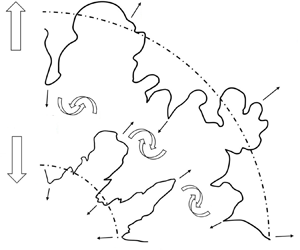Article contents
Evaluating the stretching/compression effect of Richtmyer–Meshkov instability in convergent geometries
Published online by Cambridge University Press: 03 August 2022
Abstract

Richtmyer–Meshkov (RM) instability in convergent geometries (such as cylinders and spheres) plays a fundamental role in natural phenomena and engineering applications, e.g. supernova explosion and inertial confinement fusion. Convergent geometry refers to a system in which the interface converges and the fluids are compressed correspondingly. By applying a decomposition formula, the stretching or compression (S(C)) effect is separated from the perturbation growth as one of the main contributions, which is defined as the averaged velocity difference between two ends of the mixing zone. Starting from linear theories, the S(C) effect in planar, cylindrical and spherical geometries is derived as a function of geometrical convergence ratio, compression ratio and mixing width. Specifically, geometrical convergence stretches the mixing zone, while fluid compression compresses the mixing zone. Moreover, the contribution of geometrical convergence in the spherical geometry is more important than that in the cylindrical geometry. A series of cylindrical cases with high convergence ratio is simulated, and the growth of perturbations is compared with that of the corresponding planar cases. As a result, the theoretical results of the S(C) effect agree well with the numerical results. Furthermore, results show that the S(C) effect is a significant feature in convergent geometries. Therefore, the S(C) effect is an important part of the Bell–Plesset effect. The present work on the S(C) effect is important for further modelling of the mixing width of convergent RM instabilities.
JFM classification
- Type
- JFM Papers
- Information
- Copyright
- © The Author(s), 2022. Published by Cambridge University Press
References
- 5
- Cited by



